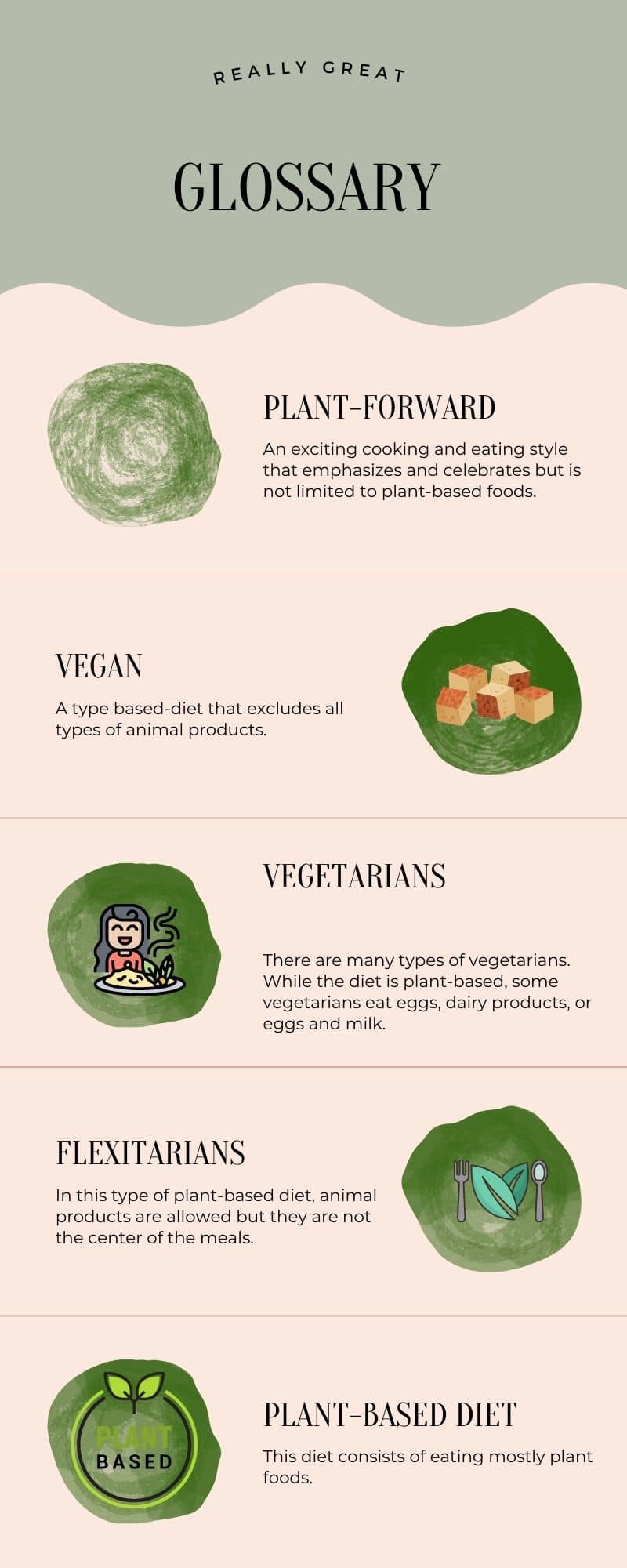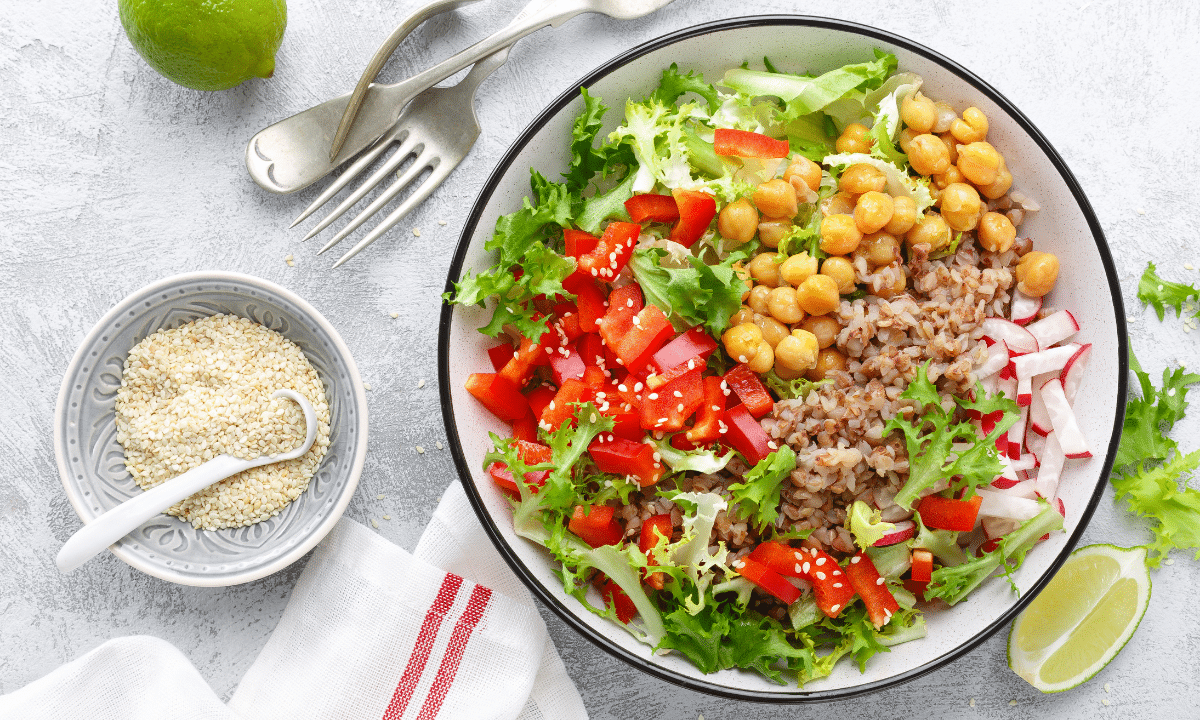What is the Plant-Forward Diet? Benefits, Food List & Sample Meals
What is the Plant Forward Diet?
According to the Culinary Institute of America, the plant-forward diet is “a cooking and eating style that emphasizes and celebrates, but is not limited to, plant-based foods.”
Table of Contents
TogglePlant-forward emphasizes eating a diet based mainly on non-meat foods such as fruit, vegetables, whole grains, nuts, seeds, legumes, soy, plant oils, herbs, and spices.
In addition to being similar to a vegetarian or vegan eating pattern, it is also focused on proven health benefits and sustainability. (1)
Because this movement comes from the culinary world, you can imagine the delicious restaurant meals and recipes that are available. A win-win for all!
The plant-forward diet is different from a vegan or a vegetarian diet.

What Foods Can You Eat?
In a plant-forward diet you can eat all foods, but the emphasis is on eating the following foods:
| Protein-alternatives | Tofu, tempeh, and seitan |
| Legumes | Beans, chickpeas, lentils, lima beans, blacked-eyed peas, soybeans, and peas |
| Nuts and nut butter | Almonds, almond butter, peanuts, peanut butter, cashews, Brazil nuts, and other varieties of nuts and nut butters |
| Seeds | Hemp, chia, flaxseeds, pumpkin, sunflower, sesame, and poppy seeds |
| Nutritional yeast | A dry vegan protein product with a slight cheese flavor |
| Grains and cereals | Whole grains |
| Fruits and vegetables | Any type |
| Plant-based fats | Healthy fats are preferred, including olive oil, coconut oil, and avocado oil |
Sample Meal Plan
If you love to cook, here are some delicious recipes you can enjoy within a plant-forward diet. If you don’t love to cook, you can use these ideas for inspiration to make an easier version.
Breakfast
Lunch
Dinner
Looking for more meal ideas? Check out my Mexican vegan diets cookbook.
Guide to Transitioning to a Plant-Forward Diet
Transitioning to a plant-forward diet is simple!
Start by adding more of the plant-based foods listed above to your meals while reducing animal products such as beef, chicken, or fish.
For example, you can begin by replacing an animal product with plant-based alternatives, such as replacing the beef in your hamburger with a black bean burger.
If you make your own hamburger patties, you can reduce the amount of meat in them without losing any of the flavor. Just chop mushrooms very small and mix them with the raw ground beef before cooking.
The mushrooms will also add a new layer of flavor and more nutrients to your meal.
The idea of this eating style is to start focusing on eating more vegetables, fruits, grains, legumes, beans, nuts, and seeds.
Later, you can make these products the center of your meals. Because the plant-forward diet allows you to eat animal protein in addition to plant-based foods, you don’t need to worry about covering every nutritional base, as deficiencies are less likely to occur.
However, it’s not a bad idea to take a multivitamin unless you’re dedicated to keeping all your meals well balanced and covering all the nutrition groups.
Plant-Forward and Sustainability
Eating more plants and less animal protein can have an important environmental impact.
In fact, a study by researchers at Oxford University suggests that limiting animal protein in your diet could be the “single most important” way to reduce your carbon footprint.
The Physicians Committee of Responsible Medicine agrees, stating that switching to a plant-based diet could reduce greenhouse gases caused by food production by 70%. (2)
While the plant-forward eating pattern might have less of a beneficial impact as it allows meat, it would still be expected to significantly impact greenhouse gas emissions.
Simple changes can make a significant improvement. For example, according to the climate change calculator, producing one serving of beans a day for a year produces the same amount of greenhouse gasses as driving 93 miles. In comparison, a daily serving of beef for a year is equivalent to driving 7,196 miles.
Of course, there are other aspects to consider when selecting a plant-forward eating style for sustainability. As an example, if your vegetables travel a considerable distance from where they are grown, then the benefit on your carbon footprint will be less significant.
Health Benefits of a Plant-Forward Diet
Most research in this area focuses on vegan or vegetarian diets. Thus, it is difficult to make definite health claims for the plant-forward diet.
However, as a nutrition expert and doctor in clinical nutrition, it is my opinion that well-planned plant-forward diets can provide many health benefits, including lowering the risk of:
- Obesity
- Heart disease
- Certain cancers
- High blood pressure
- High cholesterol
- Type 2 diabetes
I feel confident in making these assumptions based on the components of this delicious eating style, which are proven to promote better health. Science strongly supports that eating vegetables, fruits, legumes, whole grains, and plant-based oil is directly related to improved health.
Plant-Forward Financial Benefits
When saving money on groceries, one image that often comes to mind is eating rice and beans. This food is easy to make, and it’s cheap, but it is also tasty and healthy.
Of course, a plant-forward diet is much more than rice and beans, but it can still be great for your pocket. For example, by replacing one pound of steak ($6.87/pound) with tofu ($3.09/1 standard block), you can save $3.78 per meal. If you made similar changes once a day for one year, you could save $1,379. Not bad! These prices are current from my local grocery store at the time of writing.
A study conducted by the Miriam Hospital, and researchers at the Community Food Bank, reported that participants of a six-week plant-based cooking program decreased food spending while purchasing healthier food items. (3)
Another great win.
Furthermore, by adding the healthy elements of this diet into your life, you can even save money on doctors’ visits and hospital stays.
In Conclusion
The plant-forward diet is an exciting movement! Living in an urban area, I already see incredibly tasty dishes in most restaurants. Also, I find phenomenal recipes online now.
Let me know what is your favorite plant-forward dish in the comments.

Dr. Su-Nui Escobar, a Registered Dietitian/Nutritionist in Miami, FL, is dedicated to empowering women in perimenopause and menopause to live healthier, more satisfying lives.
With a doctorate in clinical nutrition from the University of North Florida, she has expertise in menopause and weight loss, including the unique challenges faced by those on weight loss medications.
Su-Nui’s passion for her field is evident in her previous role as the Academy of Nutrition and Dietetics spokesperson.


